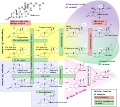 | |
 | |
| Pharmacokinetic data | |
|---|---|
| Metabolism | Adrenal, Gonads |
| Identifiers | |
IUPAC name
| |
| CAS Number | |
| PubChem CID | |
| ChemSpider | |
| UNII | |
| ChEBI | |
| CompTox Dashboard (EPA) | |
| ECHA InfoCard | 100.006.239 |
| Chemical and physical data | |
| Formula | C21H32O3 |
| Molar mass | 332.484 g·mol |
| 3D model (JSmol) | |
| Melting point | 268 °C (514 °F) |
SMILES
| |
InChI
| |
| (what is this?) (verify) | |
17α-Hydroxypregnenolone is a pregnane (C21) steroid that is obtained by hydroxylation of pregnenolone at the C17α position. This step is performed by the mitochondrial cytochrome P450 enzyme 17α-hydroxylase (CYP17A1) that is present in the adrenal and gonads. Peak levels are reached in humans at the end of puberty and then decline. High levels are also achieved during pregnancy. It is also a known neuromodulator.
Prohormone
17α-Hydroxypregnenolone is considered a prohormone in the formation of dehydroepiandrosterone (DHEA), itself a prohormone of the sex steroids.
This conversion is mediated by the enzyme 17,20 lyase. As such 17α-hydroxypregenolone represents an intermediary in the Δ pathway that leads from pregnenolone to DHEA. 17α-Hydroxypregneolone is also converted to 17α-hydroxyprogesterone, a prohormone for glucocorticosteroids and androstenedione through the activity of 3α-hydroxysteroid dehydrogenase.
Clinical use
Measurements of 17α-hydroxypregnenolone are useful in the diagnosis of certain forms of congenital adrenal hyperplasia. In patients with congenital adrenal hyperplasia due to 3β-hydroxysteroid dehydrogenase deficiency 17α-hydroxypregnenolone is increased, while in patients with congenital adrenal hyperplasia due to 17α-hydroxylase deficiency levels are low to absent.
Neurosteroid
17α-hydroxypregnenolone is a known neuromodulator as its acts in the central nervous system. Specifically, it is known to modulate locomotion.
See also
- Congenital adrenal hyperplasia
- Narave pig, intersex pigs that have low levels of 17α-Hydroxypregnenolone
Additional images
References
- Hill M, Lukác D, Lapcík O, Sulcová J, Hampl R, Pouzar V, Stárka L (April 1999). "Age relationships and sex differences in serum levels of pregnenolone and 17-hydroxypregnenolone in healthy subjects". Clinical Chemistry and Laboratory Medicine. 37 (4): 439–47. doi:10.1515/CCLM.1999.072. PMID 10369116. S2CID 41315909.
- Riepe FG, Mahler P, Sippell WG, Partsch CJ (September 2002). "Longitudinal study of plasma pregnenolone and 17-hydroxypregnenolone in full-term and preterm neonates at birth and during the early neonatal period". The Journal of Clinical Endocrinology and Metabolism. 87 (9): 4301–6. doi:10.1210/jc.2002-020452. PMID 12213889.
- Tsutsui K, Haraguchi S, Vaudry H (September 2018). "7α-Hydroxypregnenolone regulating locomotor behavior identified in the brain and pineal gland across vertebrates". General and Comparative Endocrinology. 265: 97–105. doi:10.1016/j.ygcen.2017.09.014. PMID 28919448. S2CID 5636071.
| Xenobiotic-sensing receptor modulators | |
|---|---|
| CARTooltip Constitutive androstane receptor |
|
| PXRTooltip Pregnane X receptor |
|
| |
